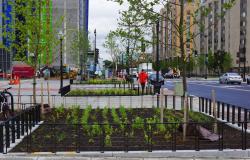If everyone Lived Sustainably, what would their Lives be Like?

Andrew Fanning finds that no country currently meets the basic needs of its citizens at a globally sustainable level. Here he reflects on a further insight from that research.
What level of resource use is associated with achieving a “good life”, and how does this compare to what is environmentally sustainable? In our paper, we looked at the current relationships between 7 indicators of national environmental pressure (relative to environmental limits) and 11 indicators of social performance (relative to the requirements of a good life) for over 150 countries. Based on the social thresholds that we chose, we concluded that resource use would need to decline by a factor of two to six times for all the world’s people to live well within planetary boundaries.
After we published the analysis, I was interested in flipping our research question around. Instead of estimating the level of resource use associated with a good life, I wanted to know what kind of life 7 billion people could expect to live at a sustainable level of resource use. Maybe some social indicators would be more sensitive to resource use than others. Maybe this knowledge would allow us to identify social goals where large gains could be made with little effect on resource use.
But how to do it? With 7 environmental indicators and 11 social indicators, I needed to understand 77 different relationships all at once! I quickly realised that such a large amount of numerical information was far too much for my mind to grasp. Since humans are visual creatures, I started thinking about how to visualise our data to see the changes in resource use associated with changes in social performance.
During coffee with Dan O’Neill (the lead author on our study) one day, I scribbled down an idea for how to visualise all of the data simultaneously. A screenshot of the interactive tool that eventually followed is shown below. The default setting for the tool is the values for a “good life” that we used in our study. The tool shows the median resource use of the 20 countries closest to each social threshold. Resource use is expressed so that a value less than one is globally sustainable (green), while a value greater than one transgresses the biophysical boundary in question (red).

The chart underscores one of our key findings: some dimensions of a good life are associated with much lower levels of resource use than others. The achievement of basic subsistence seems almost within reach at a sustainable level of resource use. Basic subsistence includes the provision of 2700 kcal of food per day, the elimination of extreme poverty below US $1.90 per day, and 95% access to sanitation and electricity.
But the achievement of other, more aspirational social goals has a level of resource use that is two to six times higher than globally sustainable levels. These goals include life satisfaction of 6.5 out of 10, healthy life expectancy of 65 years, and 95% enrolment in secondary education, among others.
But what about the original question that motivated me? What level of social performance would the tool show at a sustainable level of resource use, when I made all of the blocks turn green?

The good news is that it looks like we could meet the need for adequate nourishment of 2600 kcal per day for all people at a sustainable level of resource use (though this aggregate value says nothing about inequality within countries).
The bad news is that the levels of social performance associated with sustainability for the other ten social indicators are all below – far below, in some cases – reasonable definitions of a good life. I was surprised and dismayed to find that the basic need of improved sanitation (basic toilet facilities) has the largest gap between the thresholds we chose (95% with access) and the level consistent with sustainable resource use (60% with access). The level of secondary education is similarly unacceptable (66% enrolment).
So how do we get to a world where all people live well within the limits of the planet? The changes needed are things that Oxfam has been advocating for many years, in particular since Kate Raworth proposed her doughnut-shaped framework in 2012. The changes include dramatically reducing inequality, improving social cohesion, revitalising democracy, and rapidly switching from fossil fuels to renewable energy. But most of all, there is an urgent need to shift the goal of our economies away from the blind pursuit of growth, which is no longer improving people’s lives in wealthy nations like the US and UK, and towards the meaningful pursuit of a good life for all within planetary boundaries.
Guest post from Andrew Fanning, Marie Skłodowska-Curie Research Fellow in the Sustainability ResearchInstitute at the University of Leeds. His research article can be found on Nature Sustainability. (author summary here and there’s an interactive website)
This post first appeared on:
Image credit: Ted Eytan via Flickr (CC BY-SA 2.0)



